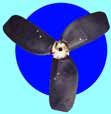

Basically the unit is designed to rotate slowly in the reverse direction due to the “ bias “ we place on the trailing edge of each blade by sanding off a small section of the rear of each foil. This creates a very low angle of attack to the blades when feathered to generate a small rotating force in the desired direction.
The design problem we have is that we have to cope for extreme events in big seas – falling off waves, broaching - and all these do happen – admittedly to only some of our customers.
Without the bias any violent motion of the vessel could force the blades to a position where for a short period subsequently the blades could force rotation of the blade carrier assembly in a direction such that it would wind up the spring and in effect engage reverse and then operate like a fixed propeller and fail to feather. The mass of the shaft / gear assembly can provide a sufficient moment such that it does not allow the propeller shaft to react as promptly as is required to prevent the spring winding up.
Anyone contemplating a voyage offshore needs the functionality of the bias in the design.
The solution is to engage reverse before the shaft starts to rotate.
Luff up into the wind to reduce boat speed to a stage that the shaft stops rotating – then engage the gearbox – normally reverse to lock the shaft.
Alternatively engage the gearbox before the shaft starts to rotate.
Engaging reverse while the shaft is rotating will usually not work as the rotating momentum of the unit will in effect wind up the spring and in effect engage reverse - the very objective we are trying to avoid.
The prop once stopped will then remain feathered – but with the bias loadings to cover all situations above.
The “ bias “ we apply to the appropriate trailing edge of each blade is therefore designed to make the prop prefer to rotate such that it won’t wind up against the spring in reverse and in effect become a fixed prop.
We have to deal not only with the extreme events described above but as well as blade damage to the leading edges from rope wraps and even paint runs which can cause quite significant forces to a foil. Look at how little ice on the leading edge of a wing can cause a plane to lose lift.
This bias induced rotation will normally only cut in above about 6 – 8 knots – depending upon hull shape, leeway, loading, leading edge blade condition and the streamlines the individual blades “ see “ in motion at that time.
In gear it will still be feathered but the blades will have a very low angle of attack with very minimal increases in drag. The Kiwiprop approach of individually feathered blades will always have less drag than a geared feathering unit where the blades are geared together and will always present an increased projected area with consequent drag increases in real world operating conditions.
So – place the unit in gear before it starts to rotate.
All the text books say there is a lot of induced drag from a rotating prop.
In addition this will reduce wear from the individual blade oscillations induced by the shaft angle as the unit rotates.
The best example one can use is a helicopter gliding down without power in auto rotate mode. For maximum lift – you want the blades rotating as fast as possible. This equates to maximum drag on a rotating prop.
It’s all about the rotating energy left in the wake.
So often contrary to initial thoughts a locked prop will usually have less drag than a rotating prop.
The approach we have adopted with the removal of a small section of the foil on the trailing edge is driven by economics. Alternative approaches would require two die sets and two lots of inventory to address both directions of rotation which can destroy the value design objectives we have emphasised in the unit.
Propellers come basically 50 % Left Handed and 50 % Right Handed because Saildrives which now comprise some 40 % of the world market for propellers are all Left Handed.
We realise now that the Operating Manual we supply was not that clear on this issue and we will expand it covering the topics above with a reference to this web page.